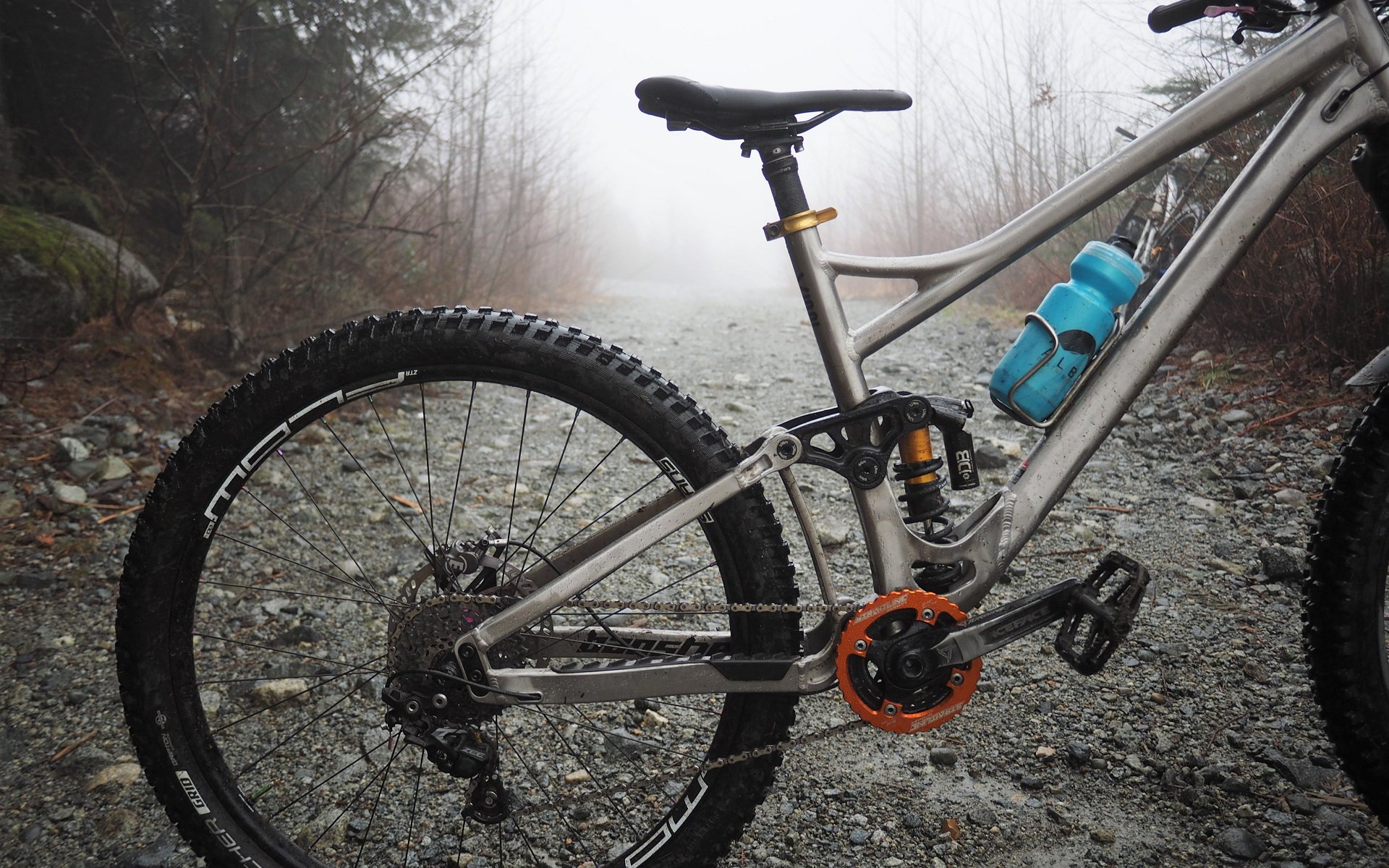
EDITORIAL | REVIEW
The SQLab 60X Saddle, Steep Seat Tube Angles, & The Banshee Titan
Straight Up
I'm fairly convinced the bike industry discovered steep(er) seat tube angles by accident as they attempted to package ridiculously short chainstays, 29" wheels, 160mm+ of travel, and longer reach numbers into frame geometry that was still actually rideable. Regardless, like any happy accident, the catalyst really isn't that important compared to the results which, by going off the most vocal accounts, are mountain bikers who are more comfortable on their bikes.
If you haven't checked it out yet, AJ put together a compelling feature on how (muscle memory, old injuries, and physiological quirks aside) a steep seat tube angle (STA) may be better for all mountain bikers. How steep? Is it 78°? 80°? 82° with the saddle nose tilted straight down and the rails still rammed fully forward in the clamps? The answer is of course yes, because like everything with bike geometry you cannot reach definitive conclusions by looking at a single number and you also cannot remove the human element. We come in a lot of different shapes, sizes, and proportions.
The bike industry, in general, has an awful track record of choosing design absolutes because trends always take precedence over engineering (see the universal shortening of fork offsets for an example) even when we have ample physiological knowledge and an abundance of prior art to implement. It's not a new theme. When the first clip-in pedals arrived on the road scene, they offered a distinct performance advantage over toe clips to anyone who could use them comfortably. Those who couldn't deal with the lack of float experienced excruciating pain, and a massive increase in the incidence of knee injuries. Ouch. As with STAs, how much float is the right amount? Is it 5°? 10? 20? Yes.
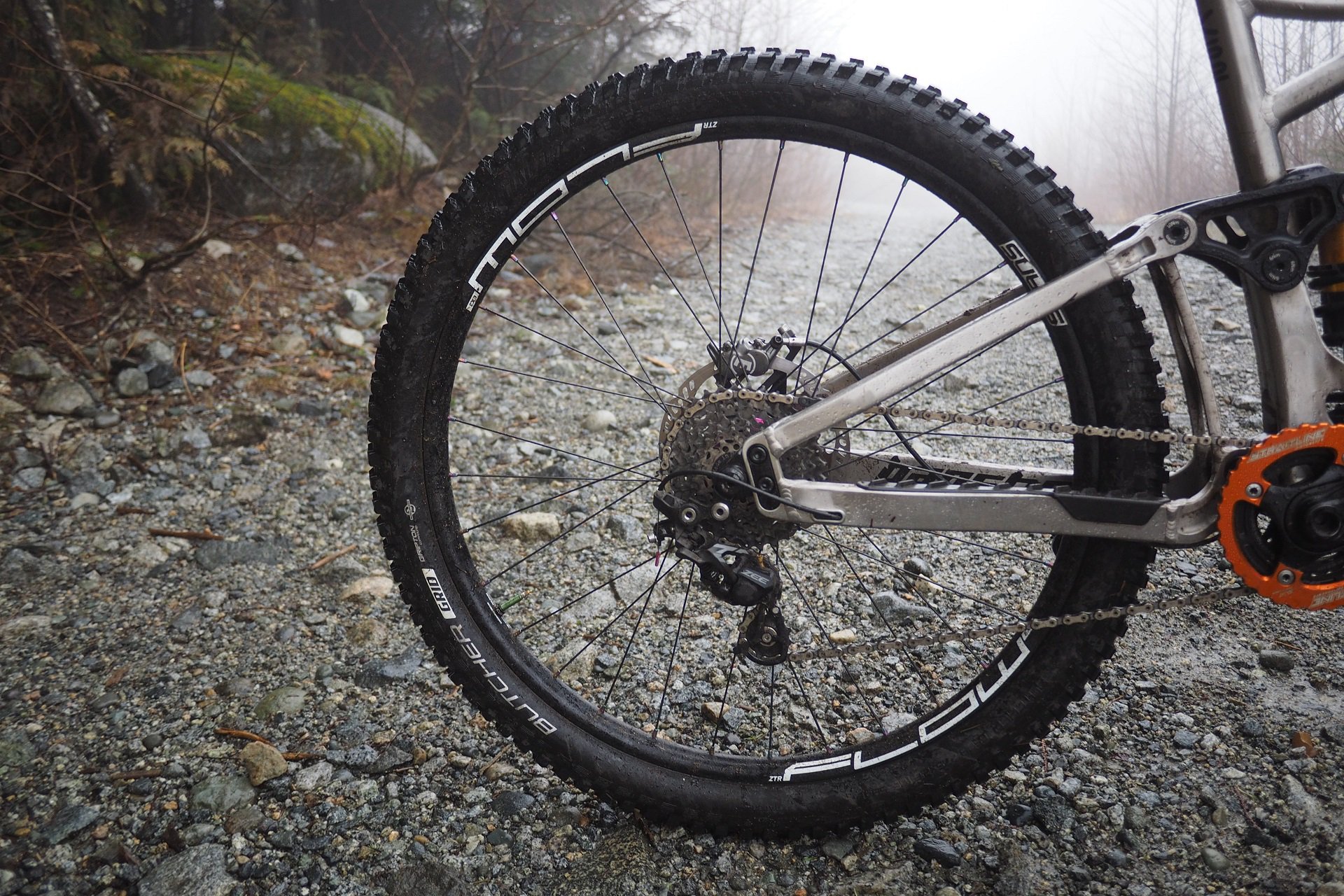
The 27" wheel looks normal to me in the back now and felt natural from day dot. Mulleting the Titan did slack out the seat tube angle a bit...
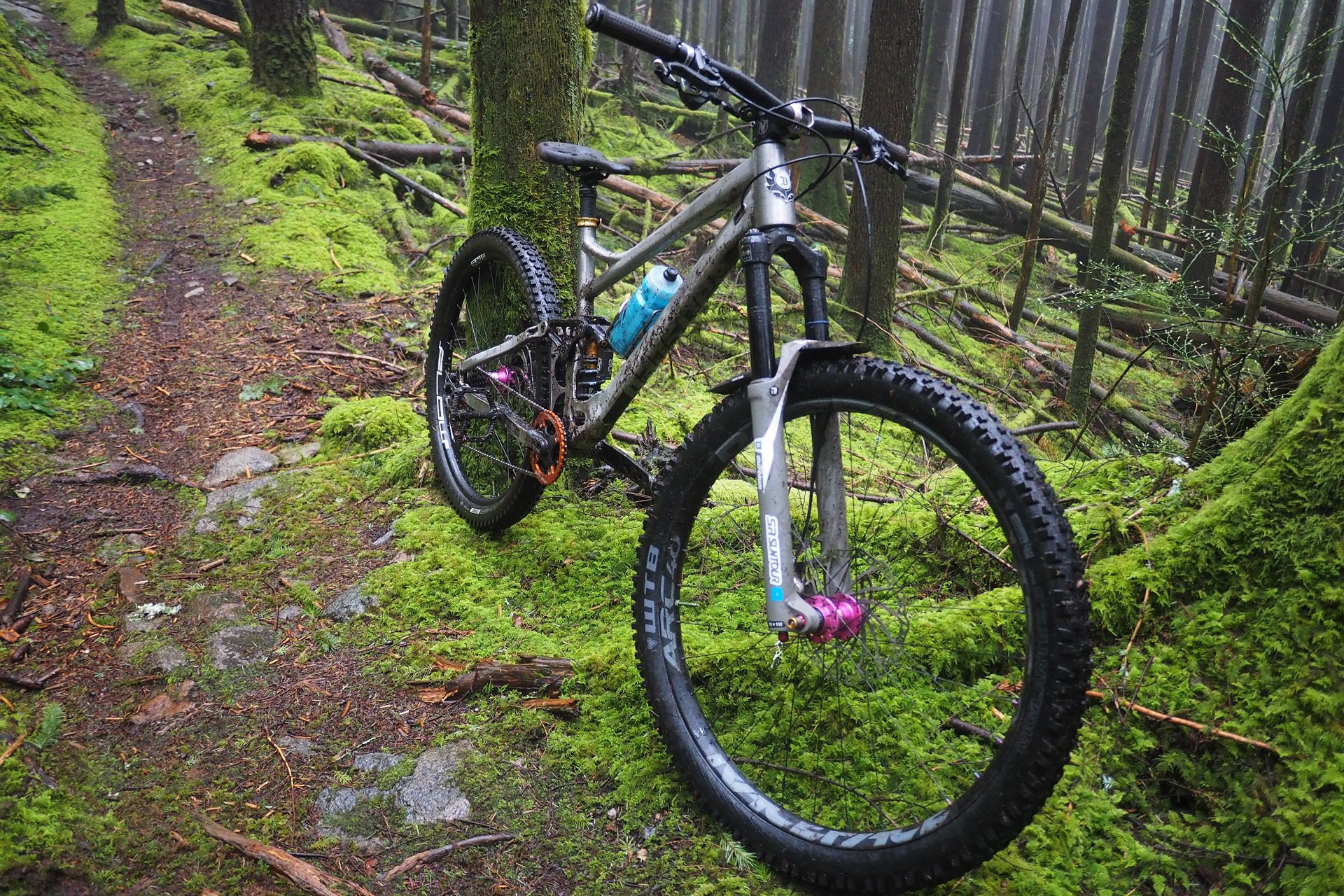
...however, I also installed a -1° angleset at the same time which increases the reach and steepens the STA some.
As AJ noted, there has been a plethora of research done on road bike fit but next to no research looking at how we power mountain bikes. This shouldn't be surprising if you follow the money. Whether it's winning races, selling products to make riders (more) comfortable and powerful in largely static pedaling positions for hours, or shops charging to fit bikes, it is both possible and lucrative to optimize road bike fit.
Mountain bike fit, on the other hand, is an interesting dark web of a subject, particularly on full suspension bikes and particularly for folks descending aggressive terrain like our local conditions on the North Shore. Riders are more dynamic, on the way up and down. Suspension setup and frame kinematics differ greatly between riders and bikes. Bar width isn't just about comfort but also weighting the front tire and steering through gnarly rock gardens. The jumps between gear ratios are significantly larger, even with 12 gears, and cleats are typically run rearwards (towards the middle of the foot) for better descending performance. In most cases outside of XC racing, bar height is compromised for better weight distribution while descending.

With the Banshee the actually steep STA means there's very little change in the effective STA as the post is raised. Less than 1° for 200mm of seat post height adjustment.
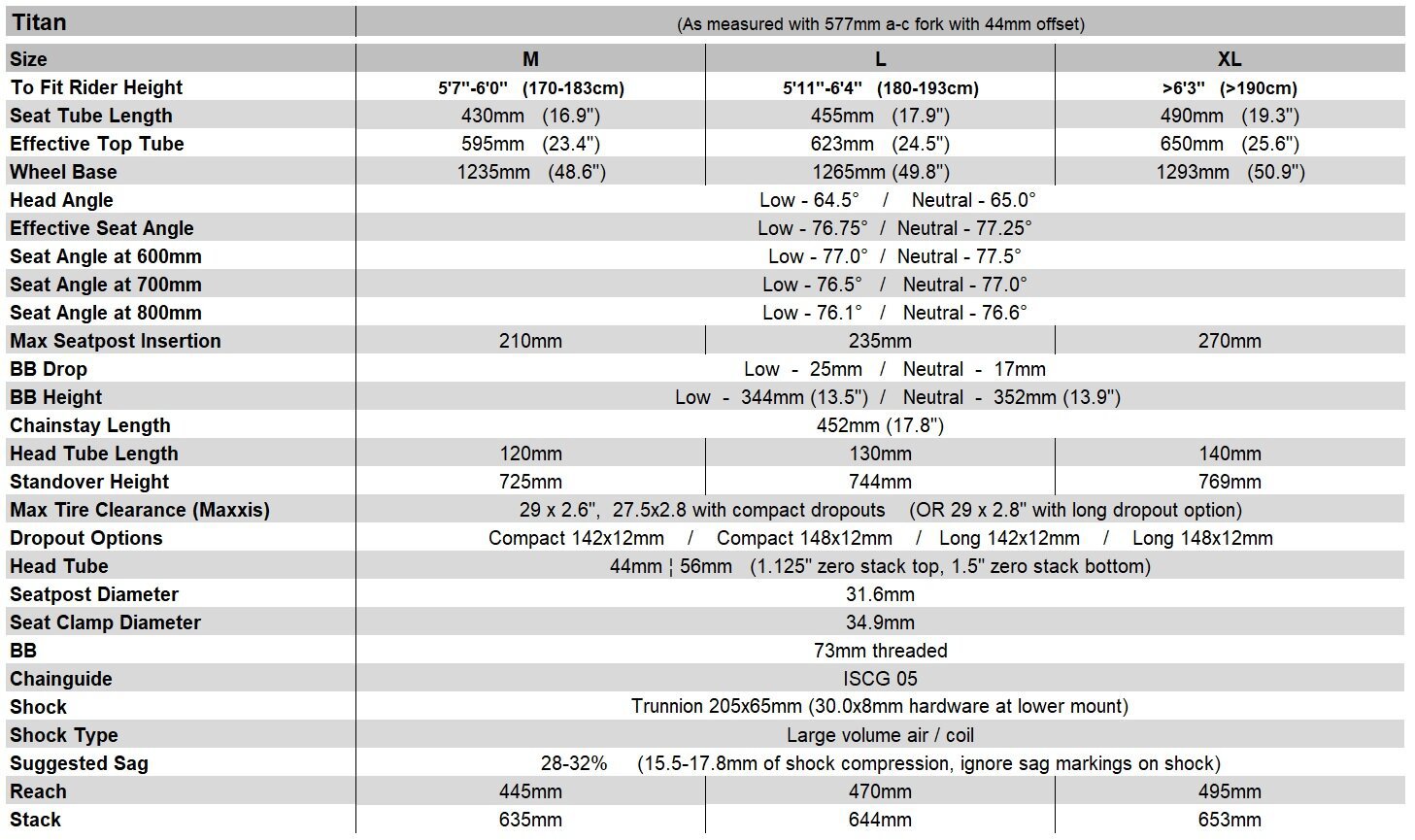
On paper 76° to 77° doesn't sound that steep for an ultra-modern full-suspension bike but on the trail, it delivers the current riding position that many mountain bikers are asking after
With road bike fit, it's important to recognize that most folks are not eighteen-year-old future pro racers. Which means comfort is as important as pure power output, and it's possible to establish a great fit for most riders, using some established guidelines and with no smoke and mirrors required. That's not ever going to be true of helping folks set up their mountain bikes due to the massive collection of variables from terrain, to objectives, to the various features of different bikes, to all the quirks of the rider.
With that in mind, before I go any further, as with handlebar width, handlebars with more or less sweep, handlebars with suspension, tire inserts, tire sidewalls, crank length, and any of the possible bicycle adjustments available, it's important that diverse fit options continue to be made available and that folks keep an open mind when shopping for a bike.
When I start feeling particularly judgemental about someone else's bike setup I always go back to this Keith Bontrager quote: "If you are a pro, you ride the fastest thing you can get. If you aren’t, then you can ride anything that suits you.” Keep an open mind, and try different setups if you can, and try and separate thoughtful feedback from full-stoke-jingoism when friends give feedback on their new-school geometry experiences.
There are a couple of exceptions to that last point. If you are employing a coach to maximize your performance on the trail, and they tell you you need an 80° STA and the nose of your saddle pointed down perpendicular to your top tube then I'd probably listen. Also, if you hate your current setup and are already uncomfortable, can it really hurt to jump on the latest trend?
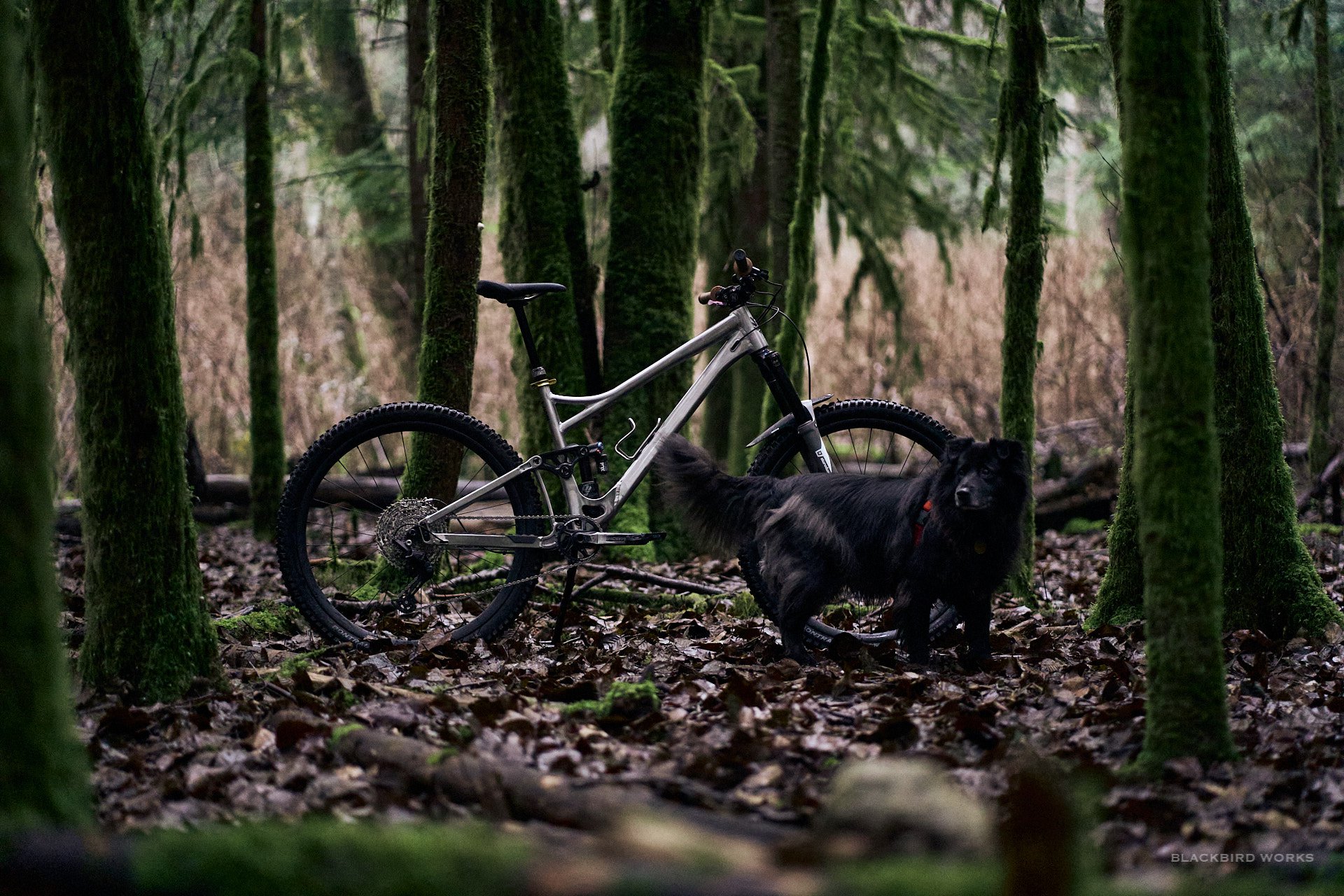
Here's the Titan with the long wheelbase setup and dual 29" wheels. For the final review, I need to coral Deniz to take some updated photos with the mullet wheel setup. Photo: Deniz Merdano
Cyclists v Mountain Bikers
Some people probably won't appreciate the distinction but when I say "mountain bikers" here I'm thinking of folks for whom riding a bicycle consists predominantly of the kind of pedal-and-plunge all-mountain/enduro riding we have through much of British Columbia. It's more about the thrill of riding aggressive trails than riding to some destination using a trail bike, which is closer to the rough road & light like the gravel road (groadie) scene locally.
At the risk of causing offense, I wouldn't call these mountain bikers 'cyclists' in a general sense and if forced to explain myself I'd draw the distinction between using a bike as a toy versus using the bike as a tool. Most of the cyclists I know personally also ride mountain bikes a lot in addition to participating in other forms of cycling - commuting, road, gravel, bike packing, etc - where the distances traveled tend to be longer, and the riding positions much more static. Their bike fit preferences tend to follow that use case even over to the mountain bike because of personal preference and conditioning.
I've been rolling this around in my head a lot lately, and aside from a couple of toweringly tall titans, I don't know a single more generalist cyclist who prefers a saddle position that's over the bottom bracket the way a 77°+ effective STA lines up a rider. Generally, riders who spend a lot of time in a more static position than the average mountain biker, describe the same issues testing bikes with truly steep seat tube angles that I've experienced myself on bikes like the Kona Satori, Banshee Titan, and Knolly Warden, where I couldn't get my saddle rearward enough relative to the bottom bracket, for my liking.
The first thing I notice is my hands and forearms go numb as weight is shifted forward from my core and into my upper body. A narrower handlebar helps a lot with this, but I can only cut so much off before descending control is compromised.
Next, I get a lot of pain in the front of my hips. I've tried raising and lowering my saddle, different crank lengths, and different saddle tilts, but I always go back to flat. The only way I've found to alleviate that pain is to pedal higher RPM in a lower gear. I think at least part of this issue is caused by increased pressure on my sit bones from the much more upright position.
The end result is that I'm notably slower than normal.
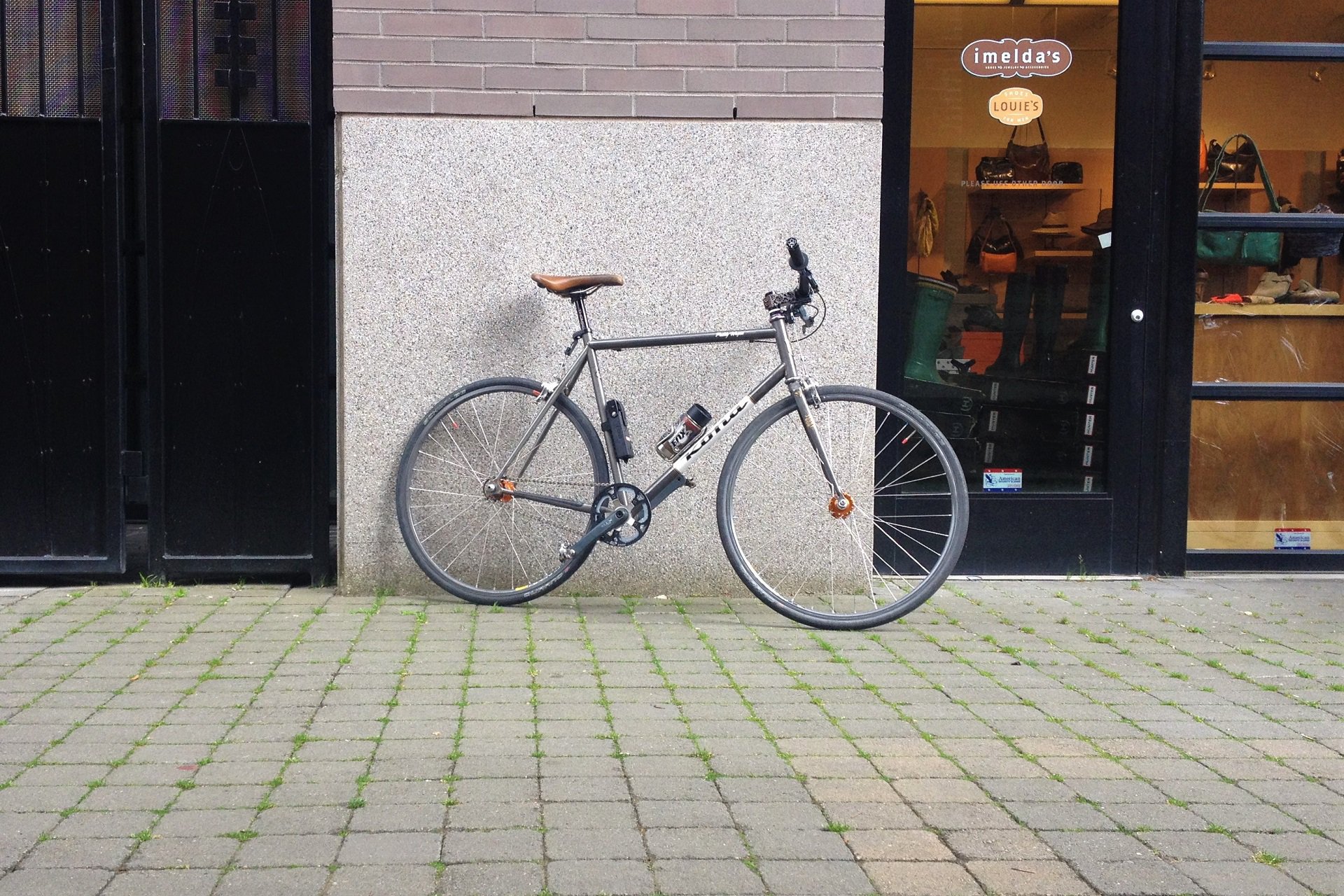
I love getting around by bike and that has a large influence on my preferred position on my mountain bike. In all my years riding, this Paddywagon is one of only two bikes that I truly regret parting with. Both are city/commuter rigs.
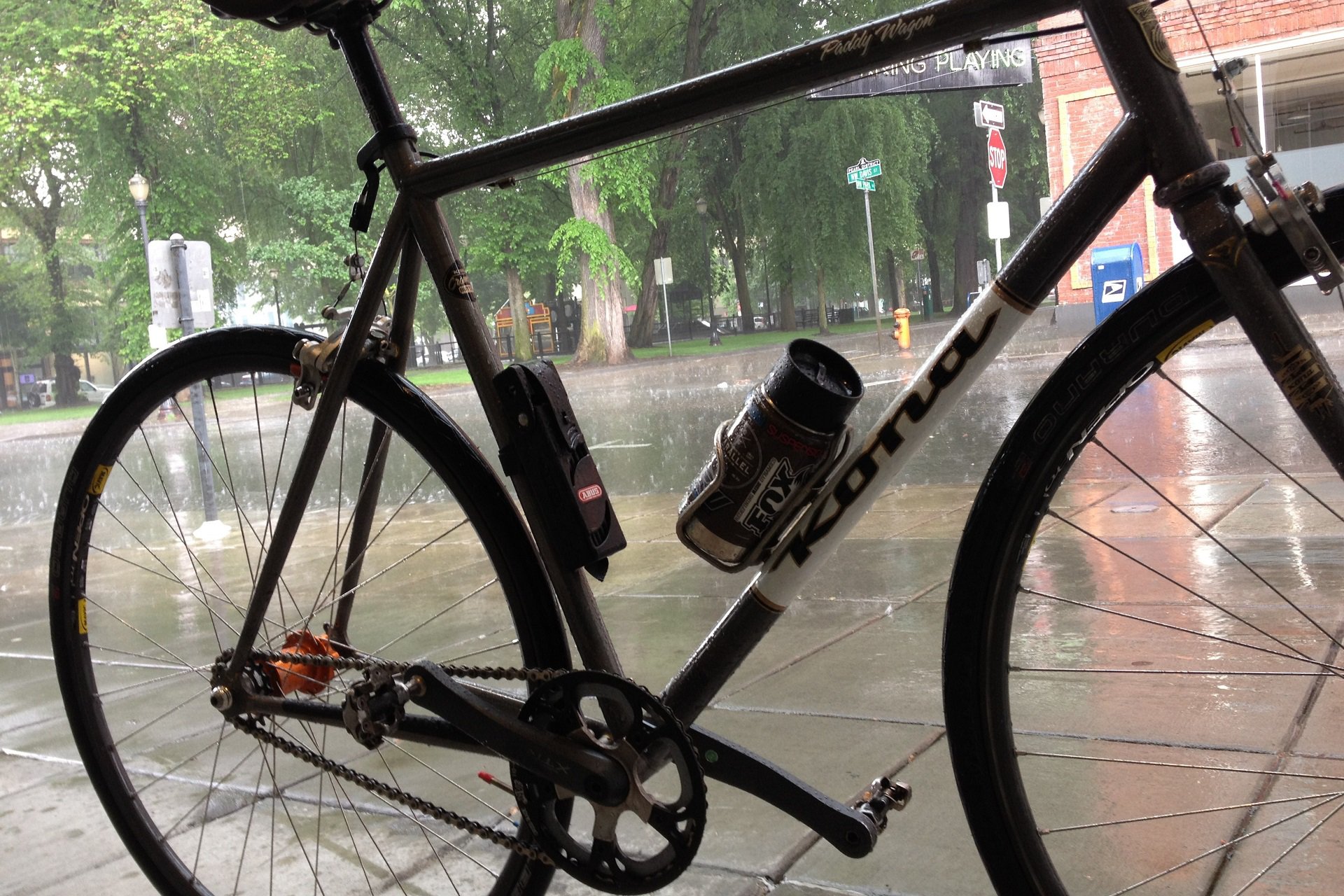
No fenders. Period. What was I thinking? My Paddywagon single speed had to go when I needed gears to pull my daughter in the Chariot. My friend D-Nutz machined down the King #1FG hub axle to fit the track spacing.
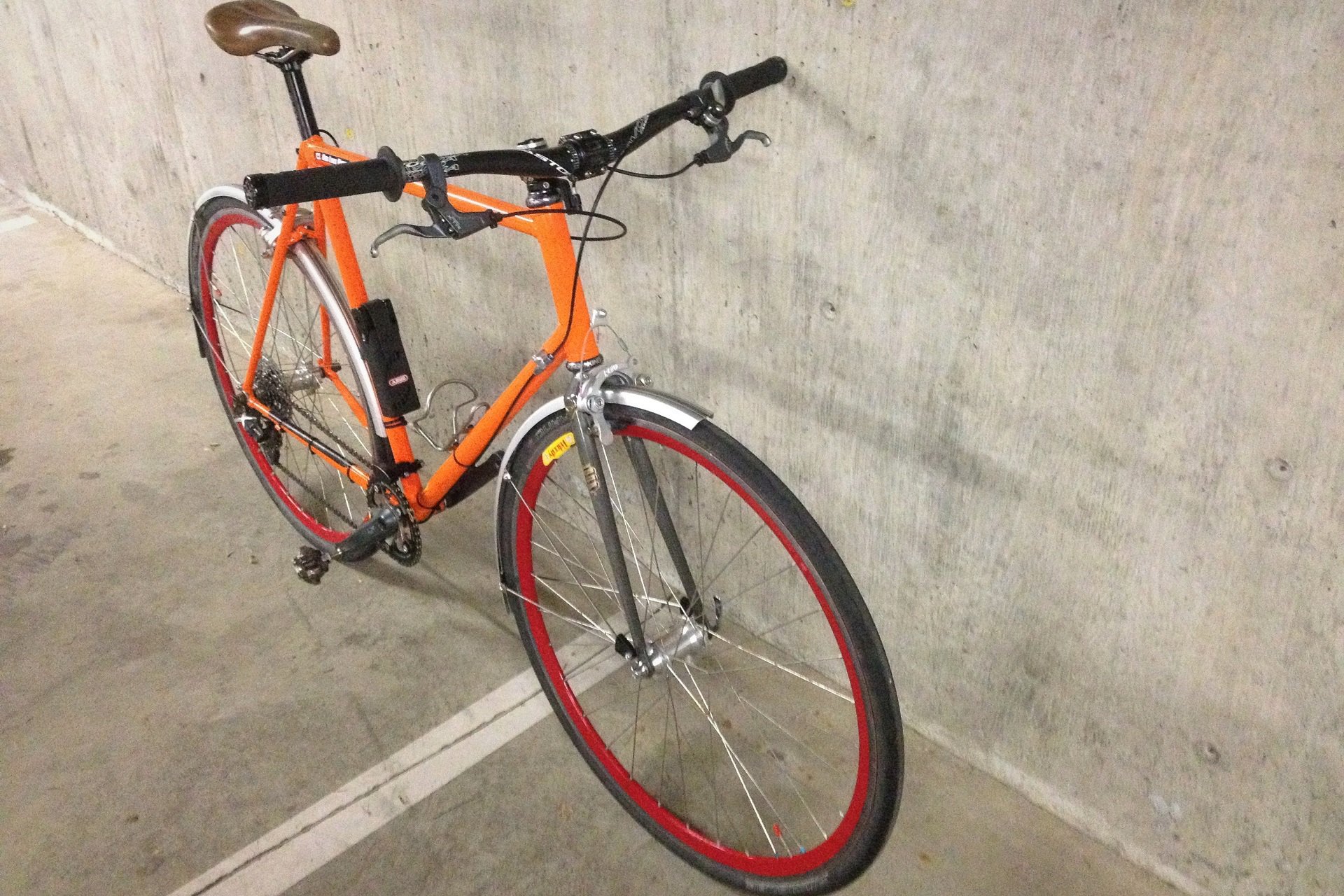
A bunch of my parts carried over to this unbadged and very orange beauty. One of the nicest riding bikes I've owned. It had to go when stopping the loaded Chariot in the rain in the hills of North Vancouver became a bit scary.
I keep going back to the need for reversible offset dropper posts. For every mountain biker I know who wishes they could move their saddle forward relative to the bottom bracket because their seat angle is too steep, I know a cyclist who wishes they could move their saddle rearward on their super modern mountain bike.
And there is certainly the argument that when it comes to maximizing performance on pedal-and-plunge trails, we cyclists may not be built for modern geometry today but could rebuild for the potential of better on-trail performance tomorrow. My issue is that I tend to spend as many hours, and significantly more kilometers, a week on my commuter bike, never mind my single speed, as my modern mountain bike and so my legs are always going to be better developed for a more neutral, flat saddle, behind the bottom bracket, bicycle fit.
What works for me may not work for you. I bring it up because despite my best efforts the current trend towards super steep STAs doesn't work well for me and so when it comes to reviewing bikes with this characteristic a portion of the review is always going to be about working a suitable fit around the STA.
I'm positive this will be helpful for folks that sit on bikes as I sit on bikes and that this information should be easy to discard for those that prefer a more over-the-BB saddle position.

In a perfect world, my saddle would be more forward relative to the bottom bracket position but only if combined with a couple more inches of top tube length. It does get around town, including grinding up steep road climbs, pretty swell as it sits.
The Titan
The Banshee Titan relies on a pair of forgings to provide the complex front and rear triangle shapes that connect the bike and these hard points are the same regardless of size. Riding the Titan, my saddle position relative to the bottom bracket would be identical whether I was riding a medium or an XL. In the low BB position that I run, with dual 29" wheels and static geo, I guesstimate this number to be around 76.5°. It would be 1/2 a degree steeper in the higher 'neutral' position.
I know that doesn't sound insanely steep, and it is actually not the most over-the-BB position I've ridden, however, keep in mind that the Titan has a relatively straight-up seat tube and where the effective STA will range wildly with other bikes that have slack actual seat tube angles the Titan varies less than 1° over 200mm of seat height adjustment. Even with my saddle slammed all the way rearward my saddle position relative to the bottom bracket was much too vertical to feel like I was going anywhere on anything but the steepest hills.
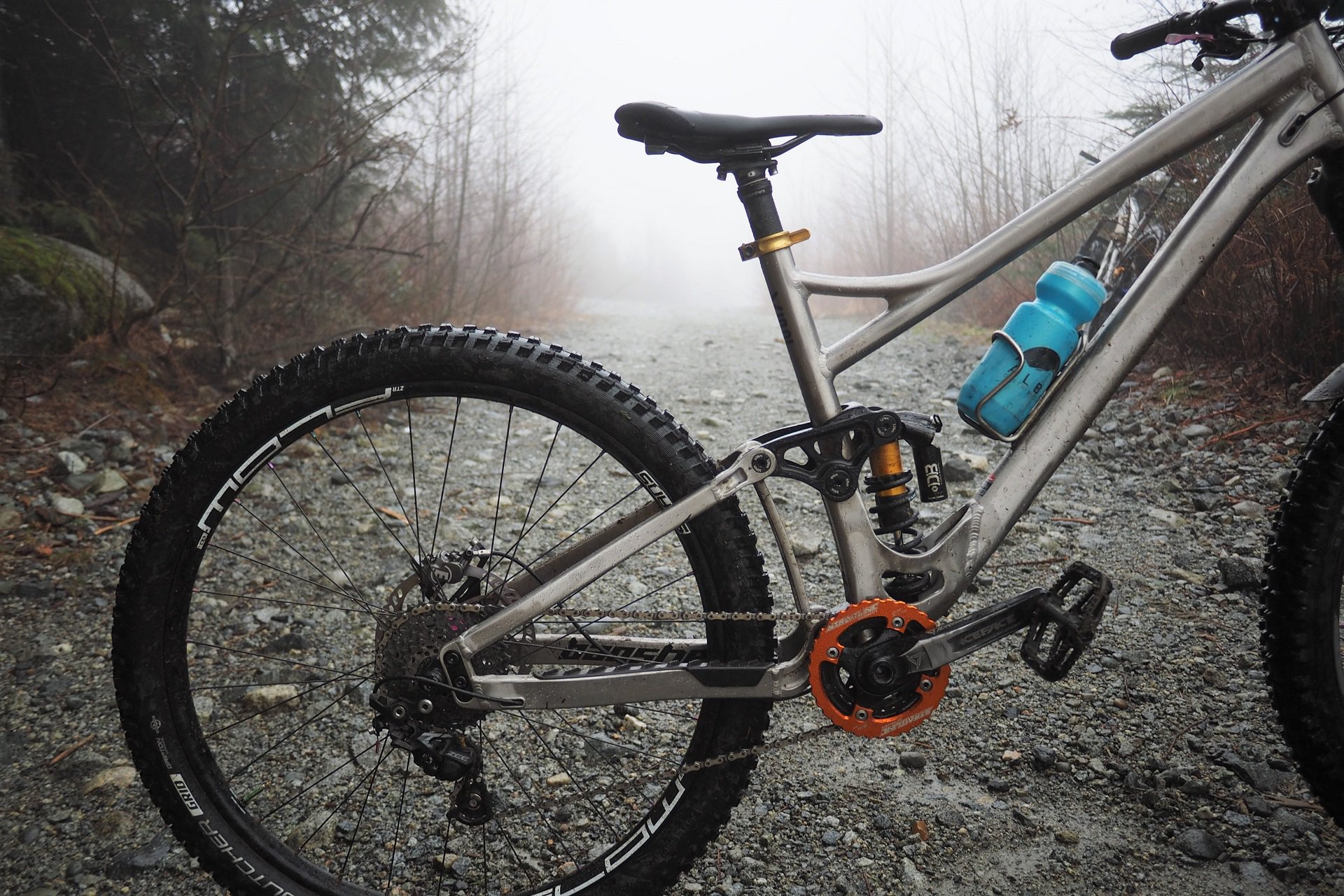
Even with the mullet rear wheel on the Titan, I've been running the low position. Switching to the high position would steepen the STA by 1/2° and raise the BB a bit.
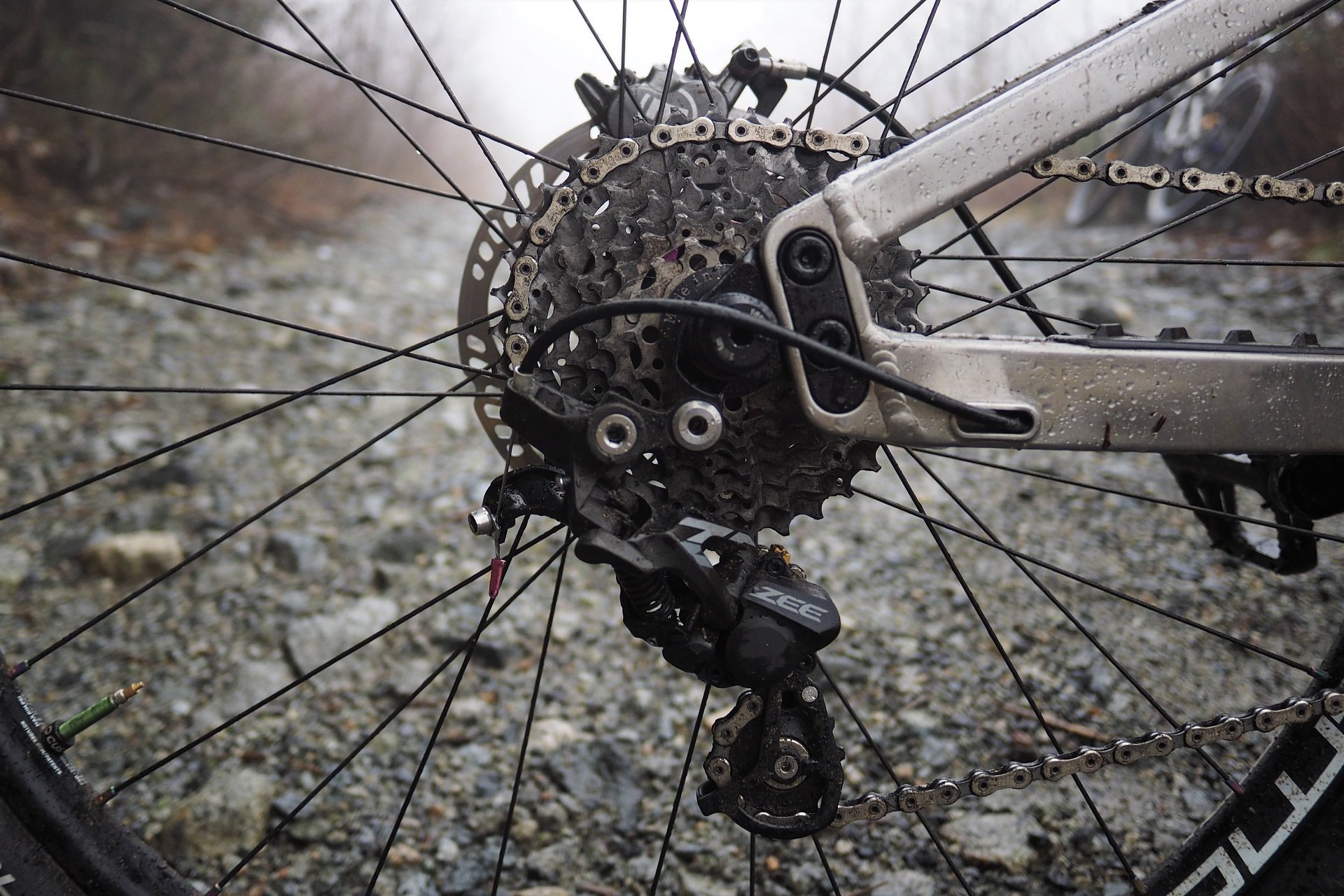
There are all kinds of ways that nerd brands could deliver STA adjustments to their bikes that, combined with fore-aft saddle movement on the rails, would deliver an optimum fit for a wider range of riders.
This should be great news for riders that prefer a position more over the BB but for me, it is one of the challenges I addressed in my first look. As my review continued to grow more and more unwieldy, I've split off a few sections, like my TriAir shock review and my 14-spd drivetrain piece, to create some more digestible chunks I can refer back to, and this is one such nugget.
I'm very pleased to have resolved my fit challenges with the Titan because it makes spending the requisite hours climbing the bike significantly more pleasant. The biggest visual change I've made is to pop in a 27" rear wheel and mullet the bike, which I'll talk about a lot more in my review. This slackens out the HTA and STA and lowers the bottom bracket. The change to the HTA and STA aren't as pronounced because of the aforementioned -1° angleset, which lowers the BB even more.
The biggest Titan surprise is that after playing around with both positions, and both chainstay lengths, I prefer the bike in the low position even with the smaller rear wheel. I've also settled on the shorter, but not short, 452mm chainstay length option.
So before going full #hotformullet, I was comfortably chugging along up hills thanks to an SQlab 60X saddle. Still run full rearward in the seat clamps, the 60X riding position moved me enough behind the BB that I felt like I was creating power and going somewhere and made an instantly notable difference to my relative speed riding with other people I know.

Some bonus beauty Titan shots from the bike's shoot with The Dentizt. The only parts from this build that are still on the bike are the Durolux fork, Magura brakes/rotors, Chromag seat collar, OneUp pedals, and King Ti bottle cage. Photo: Deniz Merdano
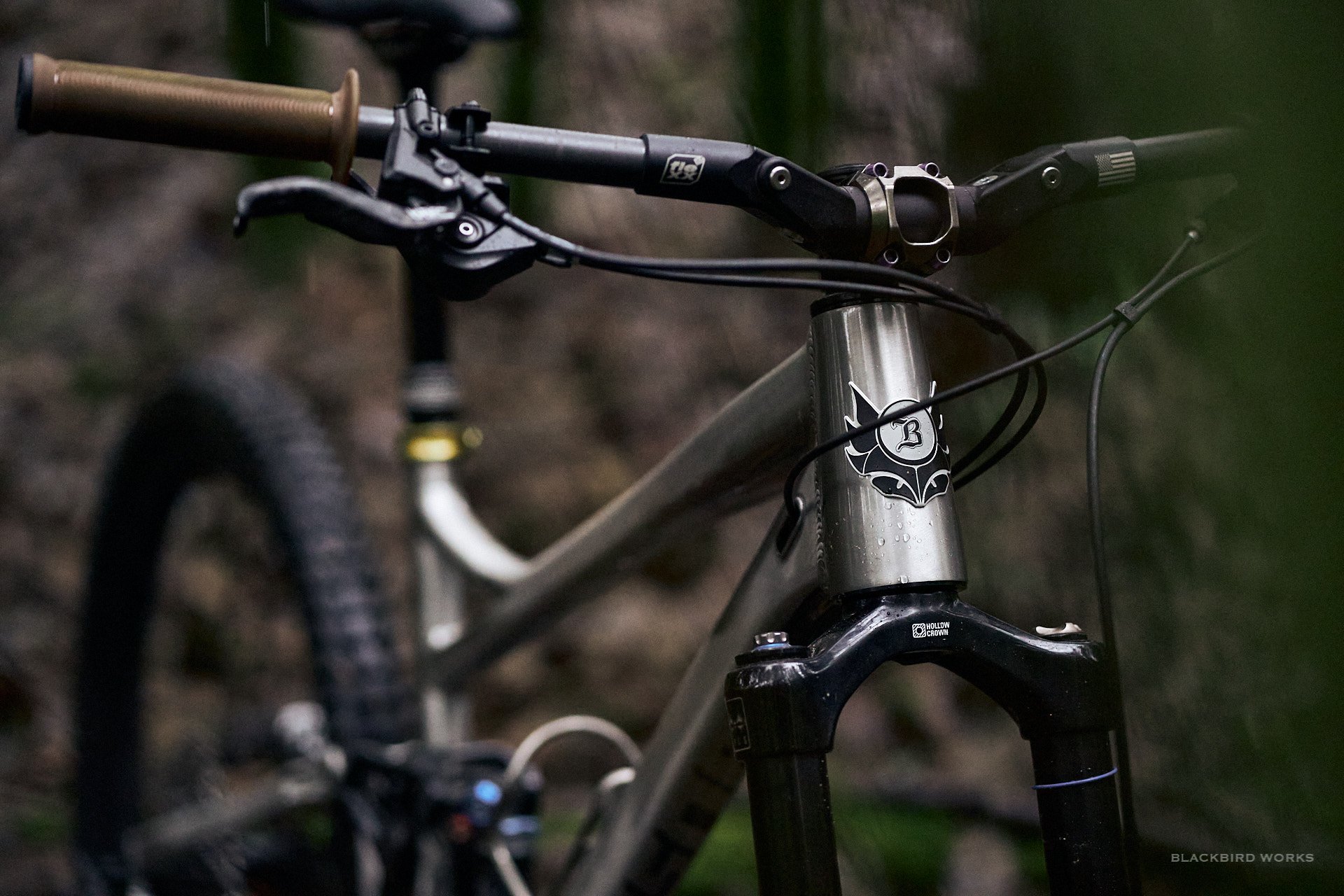
Since I get asked fairly regularly, yes the full review is coming. The issue with testing nerd bike frames using your own parts is it's hard to know when you're done trying different configurations. Just one more parts swap! Photo: Deniz Merdano
SQLab 60X Ergowave
I have very different saddles that I love for different applications but any blind bike test for me always starts with the SQLab 611 Ergowave Active platform that I tested in 2017. It's comfortable through a range of applications and different frame geometries and I really appreciate the shell flex. It's firm but at the same time as someone who has, mostly sworn off wearing a chamois, it is very comfortable. It's also the saddle I know the best when it comes to sitting and pedaling because it generally lives on my commuter bike in favour of the significantly more affordable, and much smaller, WTB Koda that I generally run on my Marin Alpine Trail and my single speed.
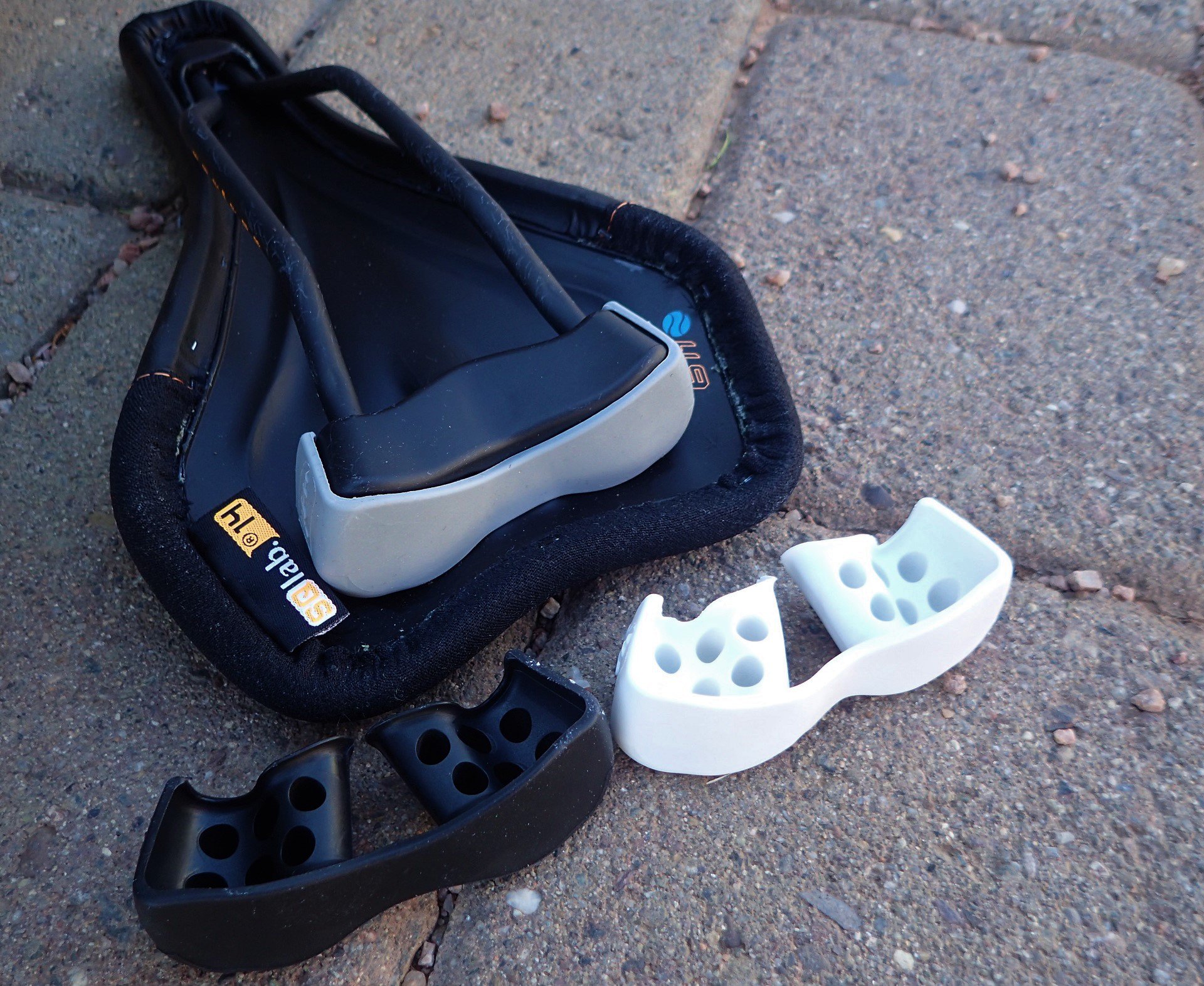
The SQLab Active saddles all work off the same principal of uncoupling the saddle rails from the shell. They ship with multiple elastomer spring rates to tune the shell flex, but I prefer to run the saddles without.
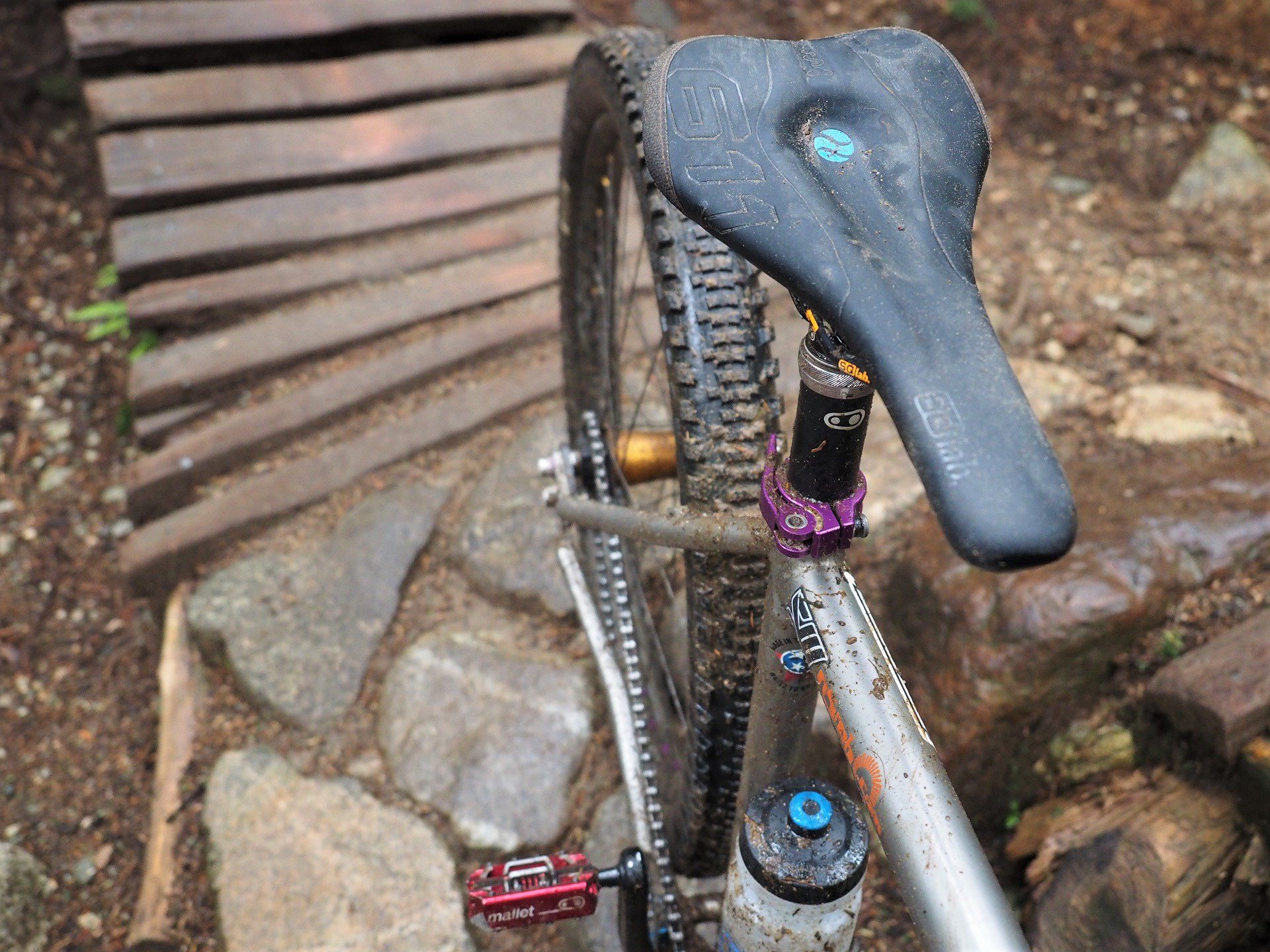
The 611 Ergowave Active is my overall, all-time, favourite saddle with or without a chamois. The mix of comfortable wing flex and support is awesome.
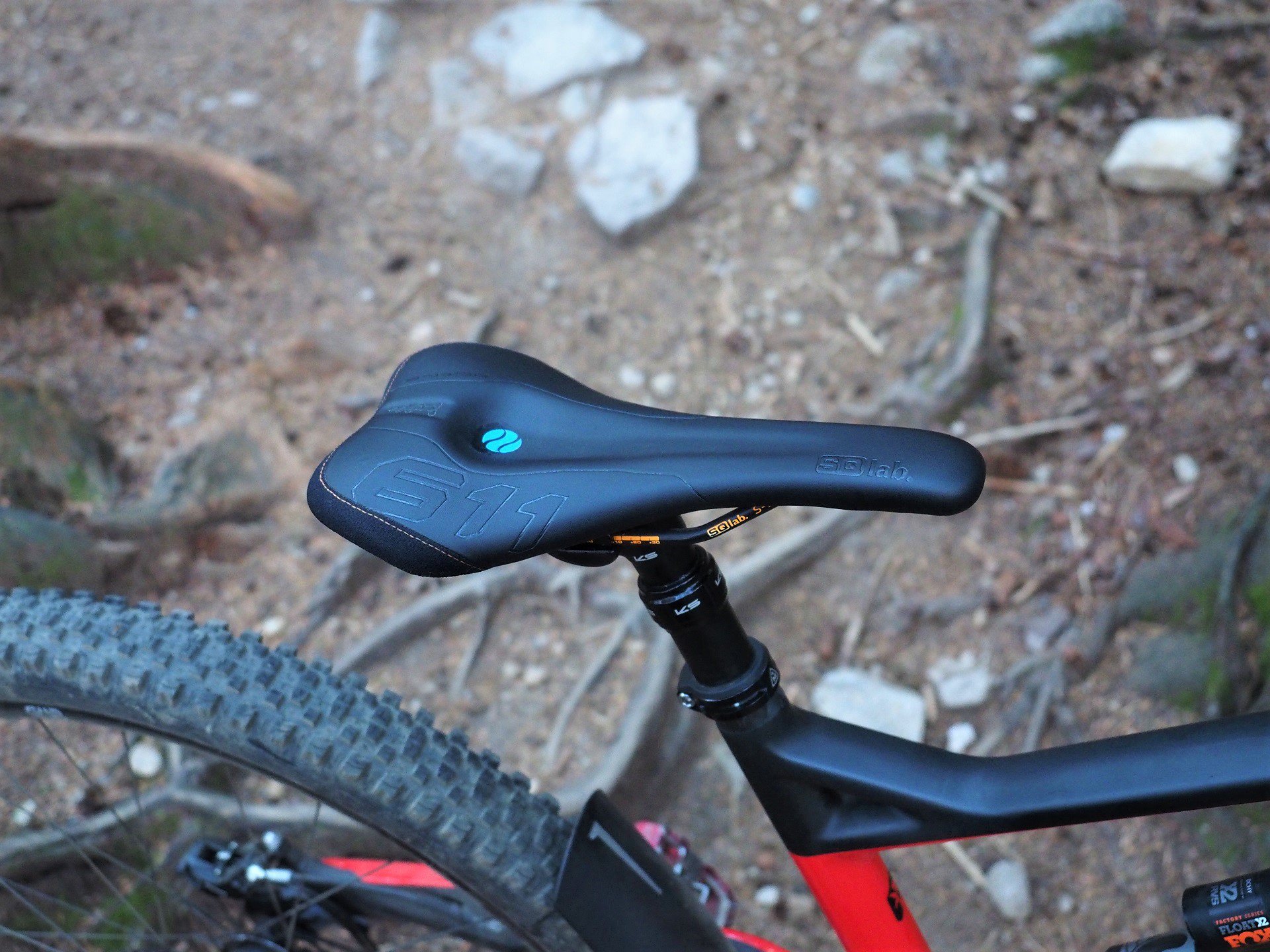
That said, it works best for me with bikes that put me in my preferred position relative to the bottom bracket. The Wolf Ridge was an interesting bike. I really liked the pedaling position.
On the other hand, when I first tried the 60X there was no instant or sustained connection. It has a similar stepped shape for perineal relief and the same flexible shape to relieve back stress, but the saddle still felt wrong mounted on any of my bicycles, including my commuter rig.
The 'well, duh' moment came when I mounted it up to the Titan just to try something else, and instantly got on with it. This saddle was designed to bring SQLab ergonomics to the much more upright pedaling positions that are generally favoured by ebike riders where there is more weight born by my sit bones than my core muscles. The combination of different pressure relief and shape versus the 611 combine to deliver a position on the Titan with the 60X that is similarly comfortable to riding the 611 on my other bikes with more saddle-behind-BB riding positions. I even noticed an immediate change in power production.
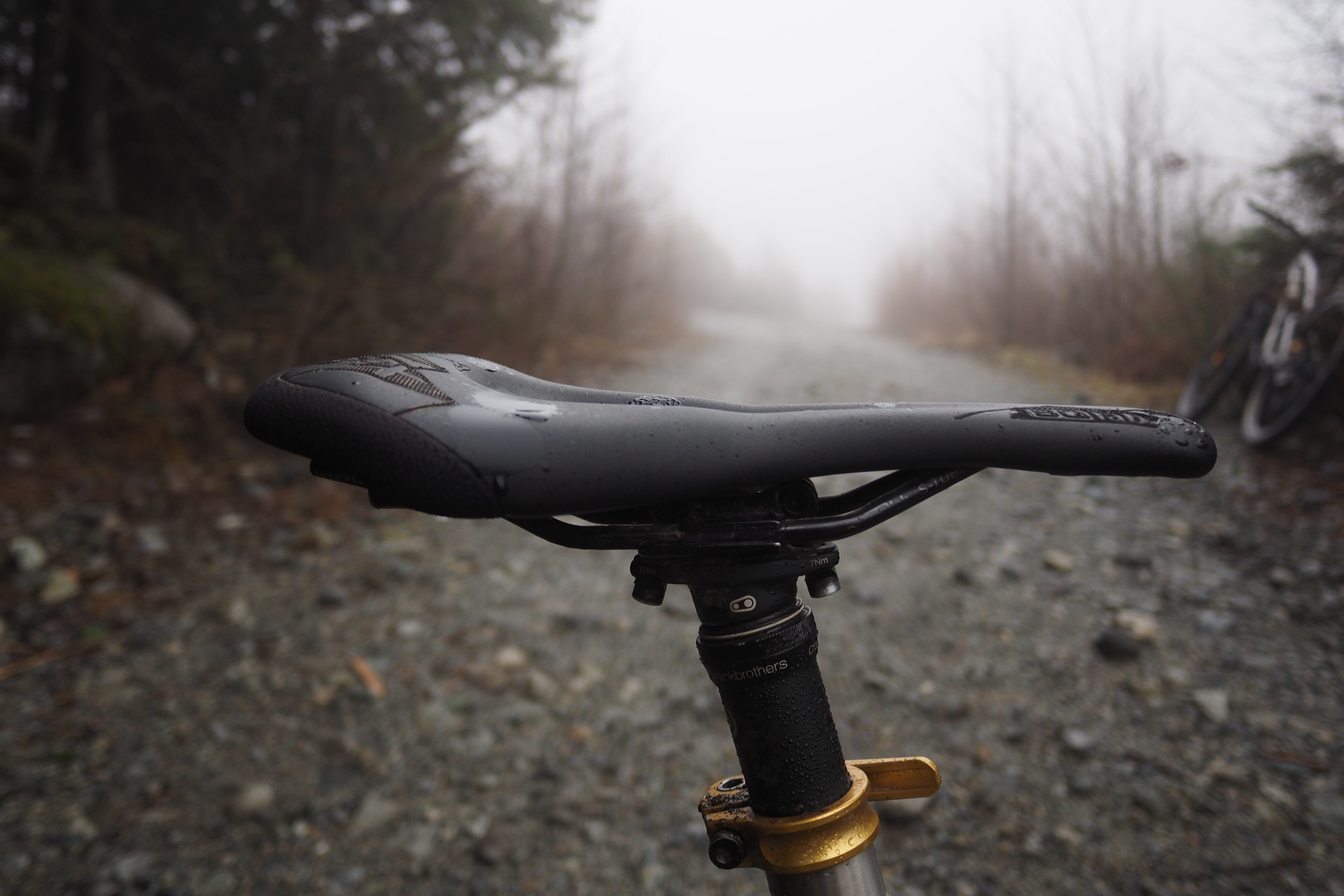
That familiar SQLab stepped shape. Like pedaling an oval chainring, the shape looks strange but feels totally natural when riding.
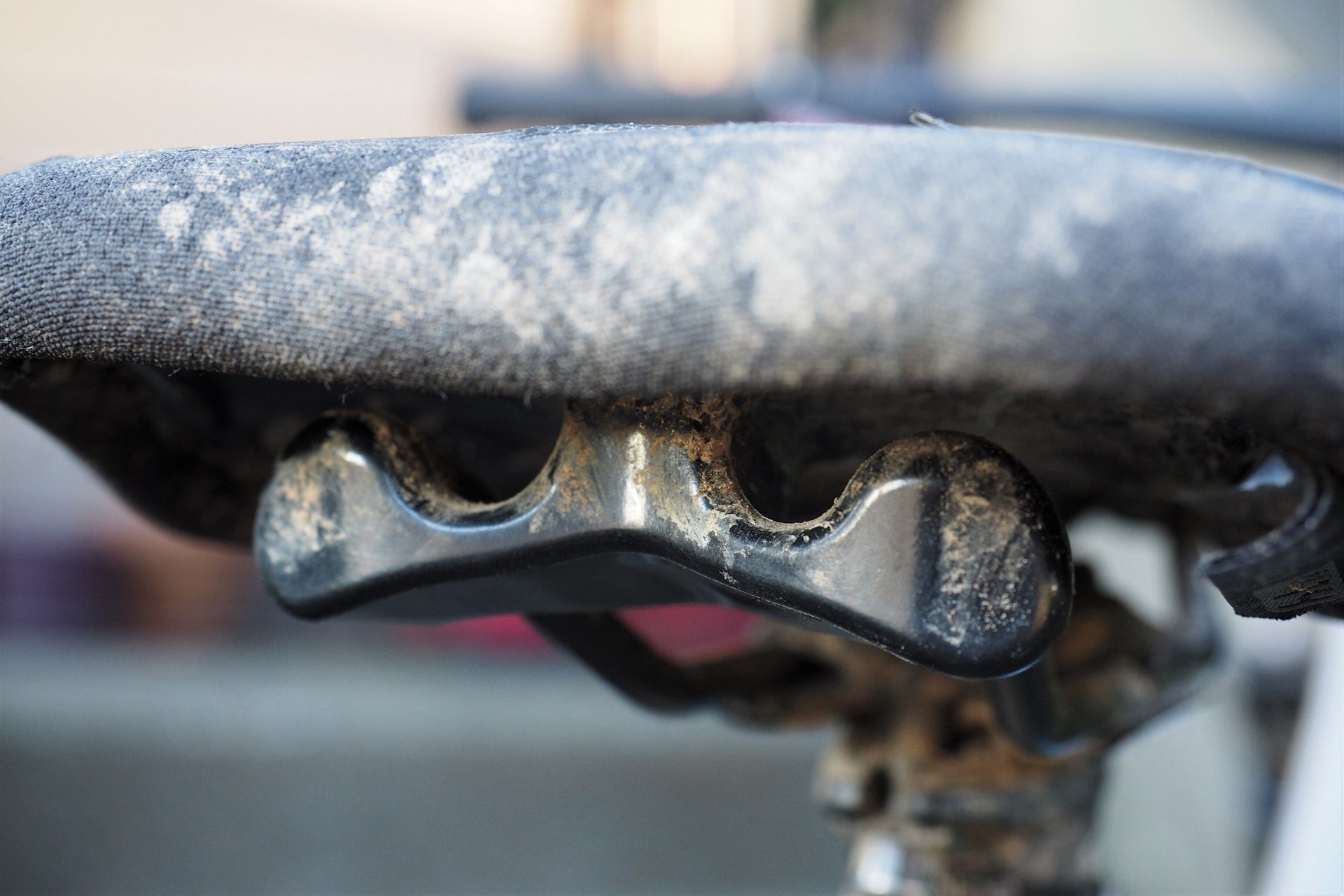
Soft, medium, or hard elastomer spring rate? I run none at all for maximum wing flex. My back loves this feature for longer static (aka in the saddle) position rides.
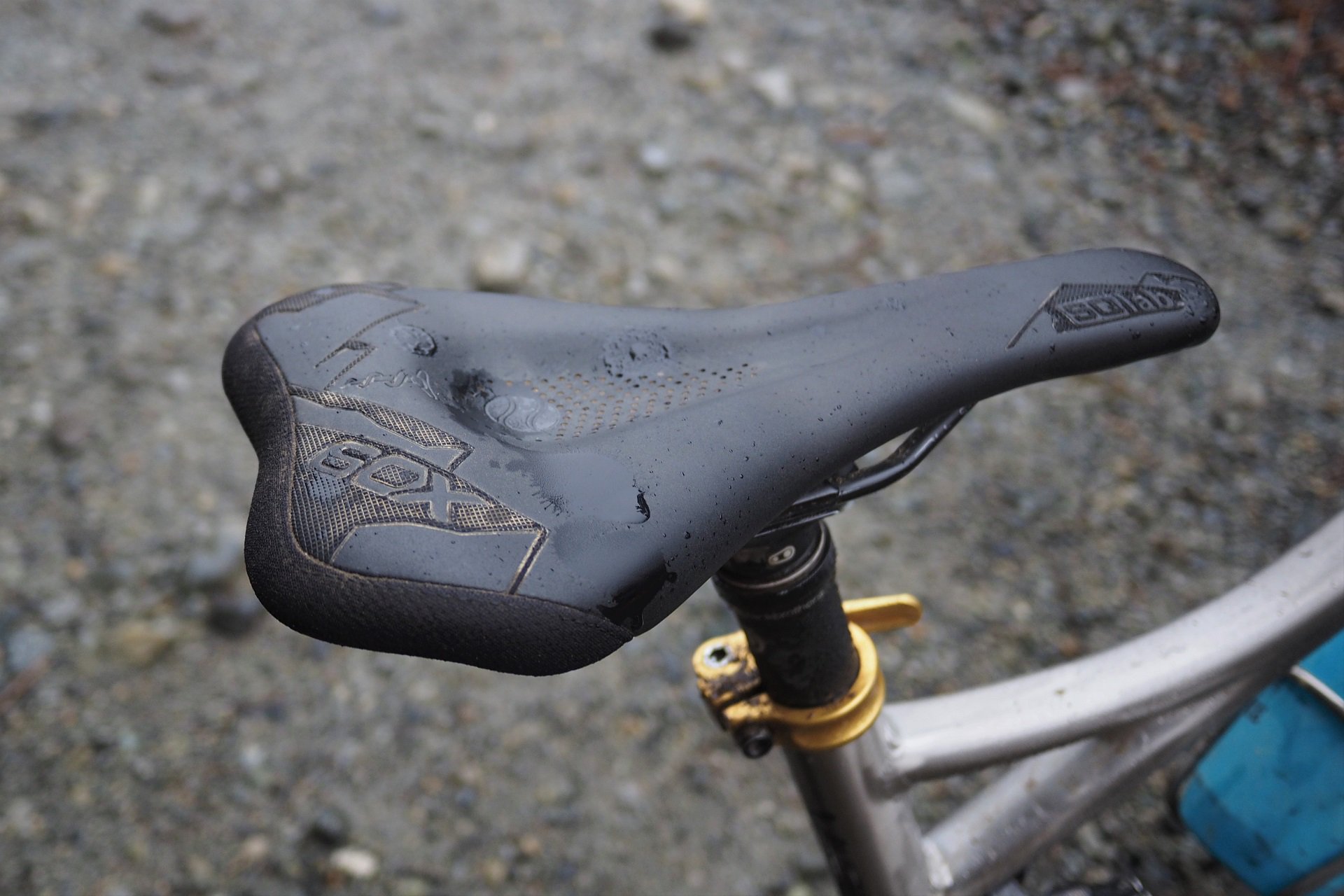
The 60X offers much more padding than my 611 which works well for the more upright, pressure on sit bones, position.
As with other SQLab Active saddles, the 60X is both obviously high quality and no small investment but in this case, it's the one component I came across that, thanks to the shape and more precisely how I sit on it, makes steeper seat tube angles work for me. It took that Titan from being a fun bike to descend on to be an awesome bike I love to take on any ride. I'm recommending it to anyone who has invested in a new rig only to find the stock range of pedaling positions doesn't work for them compared to their past mountain bike or in relation to the other cycling that they do.
Where I would still choose the 611 saddles every day for a blind test of a bike - be it a mountain, road, commuter, etc - the SQLab 60X has a combination of pedaling position and padding that works amazingly well for me with the steeper seat tube angle setup, even with the fairly stretched out position I'm running on the Titan with my 50mm stem on a size large.
If you're a cyclist, riding different types of bikes, and fit a 'modern' mountain bike as I do, then it's absolutely worth a try.
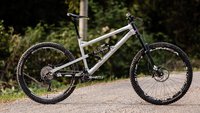
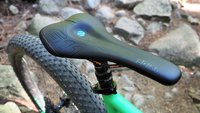
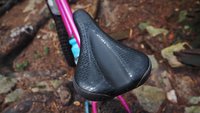
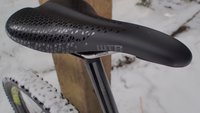
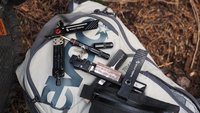

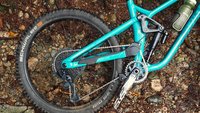
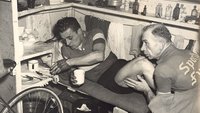
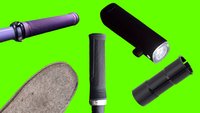


Comments
MuscogeeMasher
2 years, 9 months ago
Excellent as always. I'm a slacker STA guy for trail riding but just got back from my first trip with my Titan and was loving the steep STA on the climbs for wench-and-plummet riding. Definitely feels funny on flat-ish terrain, but worth the trade off given how I'm going to use the bike. Biggest adjustment for me was saddle position when dropped, but I got used to it after a few rides.
I'll understand if you ignore pending your comprehensive review, but do you have concerns about the housing for the dropper and the lower link? When I built mine up, I pulled the link and took off their 3M protective film and replaced it with really burly shuttle-guard tape. Housing already eating into that pretty good. Don't see a way to avoid the housing resting against the link? Am I doing something way wrong?
Reply
Andrew Major
2 years, 9 months ago
The saddle position dropped is very different from my much slacker Walt. I also don't quite have the inseam to run a 170mm post in most brands droppers - I should just get a OneUp but that's meat for the review
I have a patch of Mastic Tape on there and it's held up fine so far. As far as I can see there's no way to keep the housing from contacting the link.
Reply
MuscogeeMasher
2 years, 9 months ago
Thanks for answering! Very helpful and interesting. What I have on there is very thick and soft mastic tape from One that is sold as shuttle guard tape. Thick and soft makes sense for that application, and it works well. Used it on the link because it was what I had at the time.
I am hopeful the housing has worn a groove down to some harder rubber, but will keep watching it. If it's a problem, will just get some "normal" mastic tape to put on there.
Other than this niggle, I used some foam sleeves and zip ties and the cable routing was easy and is quiet. The little two-piece clamps that fit into the ports are brilliant. Wish they had done on the drive-side chain stay as well or just gone external. My OCD doesn't like the open ports.
Really looking forward to the review and very, very happy with my frame.
Reply
Andrew Major
2 years, 9 months ago
I would have gone external on the chainstay for sure. What dropper post are you running and how much travel? My one tick is still how limited the seat post insertion is... they should probably just ship with a OneUp dropper.
Had an awesome ride on the Titan today actually. I have plenty of little nitpicks for the review but I do truly love how the bike rides.
Reply
MuscogeeMasher
2 years, 9 months ago
Post insertion is probably the main, and maybe my only, true substantive gripe that actually affects performance. At a little over 6’1” with longish legs, on an XL (really like the fit and I’m not a long-reach evangelist) running a 185 Divine. Have Revive’s on both my hardtail and trail bike I ride locally and very frequently. Could have gotten 190 with a OneUp, but love me some BikeYoke and liked staying with one from a spare parts and service standpoint. Would break my mid-tier, trip-bike promise to myself and cough up the dough to put a 213 Revive on the Titan if it would fit. Plenty of room above the seat post collar. It’s just the insertion.
Reply
Andrew Major
2 years, 9 months ago
It's just insertion for me as well. Going to try a OneUp post as they're the best in the game for insertion depth v. travel.
MuscogeeMasher
2 years, 9 months ago
Also, and I know you’re struggling to keep the review short, I’d be very curious about the pedigree of the headset. I know they did things right with the suspension bearings, but have no idea on the headset.
Reply
Andrew Major
2 years, 9 months ago
Headset looks okay, and there are bearing upgrades out there when they wear out. I get why they included it - many people buying one of their frames will have all the tools to build it up themselves except for a headset press. I didn't have the stock headset in long enough to say what the bearing life will be vs. say a Cane Creek 40.
edgibson22
2 years, 9 months ago
I don't know this for sure and don't know how or where to get it but I've read that people are shimming the v3 banshees and using 30.9 posts. Getting an extra inch or so of insertion for the 210 droppers. That's what the internet told me anyways. Might be worth a look.
Reply
Andrew Major
2 years, 9 months ago
I did have a post shimmed in for a while - 31.6 to 30.9 shims SUCK though. That said, it's a great point and I will try and measure what the difference is going to 30.9 (I have a post around). I would certainly guess it's a CM at most but I'll confirm for the review (thanks!)
MuscogeeMasher
2 years, 9 months ago
Great point! Should have thought of that, although I hate the idea of using a shim. I think you'd need to pick up 2-3cm of insertion to make it worth it. While I'm sure more drop would feel good, it wasn't the height of the saddle that bothered me at first, but the fore-aft postion. To remedy that with more drop, guessing you'd need 2-3cm to really make a difference. Will be very curious to see what Andrew says after he measures. Finally, do 31.6 and 30.9 use same internals, so no loss of durability? I think they do?
Andrew Major
2 years, 9 months ago
Internals depend on the post. Wintek equipped cartridge posts the cartridge dimensions are the same.
We used to often shim 27.2 posts into interrupted 30.9/31.6 to gain space in the pre-dropper days. But a truly long travel 27.2 dropper would certainly not hold up and I don’t think they come longer than 125mm.
I’ll certainly come up with a number.
Yes, in my experience the steeper STA absolutely requires a longer drop to get the equivalent amount of saddle out of the way feeling.
Andrew Major
2 years, 8 months ago
So just to follow back on this, it's a total myth comparing apples-to-apples but if they were switching from a post with a larger actuator (say an e13 Vario or Crankbrothers Highline 7) to a post with a smaller actuator (say a PNW Rainier) then they could grab some extra insertion depth.
I happen to have access to a couple of identical posts in 30.9 and 31.6 and with the identical posts I had no difference in insertion going from 30.9 to 31.6.
That said, with the OneUp V2 Dropper I gained 20mm of post-travel over anything else I had access to and I don't have it fully-completely slammed. That's the product I'll be recommending with the Titan.
Lu Kz
2 years, 9 months ago
> wench-and-plummet riding.
Now that does sound fun!
Reply
Andrew Major
2 years, 9 months ago
Heh, totally missed that when I first read the comment.
Reply
MuscogeeMasher
2 years, 9 months ago
Same as pedal and plunge, but I find “wench” to be very descriptive of my climbing speed in the big mountains!
Reply
Andrew Major
2 years, 9 months ago
I've heard it called "winch" and plummet. But never "wench" and plummet...
Reply
Vik Banerjee
2 years, 9 months ago
I guess I am a cyclist [aka STA slacker] who also rides technical mountain bike trails. I'm glad you found a compromise on the Banshee you like.
Reply
Andrew Major
2 years, 9 months ago
It’s a theory!
The Titan and I get along very well. I’m loving it as a mullet.
Lots to say too. In general the review was getting so huge in my mind that I started chipping off bits and including my rolling thoughts for discussion with pieces like this, 14-spd, TriAir review, etc.
Reply
Cr4w
2 years, 9 months ago
It totally makes sense that you'd want different ESTA for different thing. At 6'6" most of the one-size-fits-most trends in mountain biking don't apply to me effectively. I love steep ESTAs but no way am I clamouring for that for every bike and every application. My FS bike is 79' with the seat quite forward on the rails but my HT is 76' with the saddle centered. My road/gravel bike is 73' with the saddle only barely forward of center.
Reply
Andrew Major
2 years, 9 months ago
Do you use any kind of lockout/Propedal with your shock or ride with it open all the time? Would be interested in seeing how similar you actual position relative the BB is when you're climbing your hardtail v. your FS bike. Similar chainstay length on both?
The curious thing for me is a cyclist being able to run multiple different positions between bikes but you're a generally ripped dude so it may be your muscles are developed/balanced enough that you can adapt to multiple riding positions and still produce solid power?
Reply
Cr4w
2 years, 9 months ago
The HT and FS both have the same length CS. The HT has 180mm cranks where the FS is on 175s. I have very comfortable climbing positions on both bikes.
I run the lockout on the G1's EXT - this is the first bike I've had where the shock's activeness hinders climbing.
As long as I'm riding all three bikes often enough switching isn't an issue. If it's been a while then that first ride back can be a bit weird. As I get older it seems increasingly important to be as versatile and adaptable as possible.
Reply
Andrew Major
2 years, 9 months ago
Is the EXT lockout a true lockout plate (rigid with blow-off) or a compression preloader like Fox where you just get a bit more support but traction remains?
Reply
trumpstinyhands
2 years, 9 months ago
Riding a hardtail with a 77 degree seat tube angle, this has reminded me that I need to angle the nose of my saddle up a bit. I always have it flat, but moving the saddle so far forward, and having the front of the bike dropping a bit when on it means that I am constantly sliding forward on the saddle. The trend for really steep angles and horizontal brake levers insinuates that bikes are only for riding up super-steep climbs, and then down cliffs.
Reply
Andrew Major
2 years, 9 months ago
What hardtail are you riding? Honzo ESD?
I was looking at Honzo's the other day (wish they had a longer rear center but either way I still love them) and I think for me a Honzo ST with a -2° angleset would be the winning setup. Similar geo with a 150mm fork except with a much slacker STA for producing power.
Reply
tashi
2 years, 9 months ago
I’m a cyclist of painfully average bodily dimensions who started with road bikes over 30 years ago and I prefer steeper seat tubes on MTB’s.
I have been shifting my seat forward for a few years in the road bike to facilitate a higher cadence. I started trying it on the mountain bike and, particularly combined with tipping the saddle down a bit, found that much of my lower back pain went away.
Reply
Andrew Major
2 years, 9 months ago
Do you still road ride / commute / city ride a lot or just mountain bike?
I'm curious if you've adopted your steeper MTB position to the road or if you have gotten used to two very different positions on your different bikes.
Reply
tashi
2 years, 9 months ago
Scooched the seat forward on the road bike to facilitate a spinnier pedaling style (inspired by Lance’s post cancer technique) a few years back.
Figured out the connection between my seated pedaling position on the MTB and acute back issues with my physio and started scorching forward on the mountain bike. Went for a steep seat tube when swapping frames. Back loves it and I think it likes longer reach as well.
Mountain biking is the bulk of my riding these days.
Reply
Andy Eunson
2 years, 9 months ago
Yes. I think you are right about steeper seat tube angles being an accidental discovery. I sense the longer reach longer reach call increased top tube measurements which we all used to find a bike that fit so seat tube angles were steepened accordingly. That also allows room for wheels and suspension travel and the short chain stays we are told we love. DH out front, BMX out back. The ultimate mullet. I thought the longer reach allowed a rider to keep their weight more evenly balanced between the wheels. Slack angles and higher trail measurements give a more stable ride plus with a short stem allows us to weight the front end more without fear of going over the bars. Long stems of yesteryear forced us way back with little weight on the front and less traction than we wanted on the front wheel. Longer reach really helped that OTB thing go away but still I think the short rear centre is not really matching that front end.
On many bikes you could keep the same wheelbase but slacken the seat tube angle by simply moving the bb location forward. Like a Pole. What would that do to weight distribution through the feet? We all move our weight back relative to the front end to allow for the forces of hitting things like braking bumps, roots, braking forces, big rollers etc. To me that would seem to place more weight on the back wheel and if the chain stays are super short, too much weight bias to the rear. Move the bb forward and that changes that.
Short rear centres are not as good for climbing. There’s a reason why hill climb motor bikes have ridiculous swingarms. In the olden days we used to say we needed a long stem to keep our weight over the front wheel on steep climbs but that was stated wrong. We didn’t want the weight the front wheel, we wanted our weight ahead of the rear contact patch. When we lower our body climbing, we aren’t just getting our centre of mass in a better place we are also pulling back on the bars to offset pushing a bit forward at the top of the pedal stroke. Look at just about anyone hammering a steep pitch and you’ll see forearms parallel to the ground. Sitting more upright doesn’t work for hard uphill efforts. For slow easy climbs sure, it may be more comfortable to sit more upright. But I don’t think it’s more efficient.
Steeper seat tube angles will change your seated balance and may place more weight on your hands leading to comfort issues like Andrew mentions. You’ll probably need to raise your bars, or move your feet forward or saddle back to achieve balance. Shorter cranks will affect fit too. Lots of people moving to shorter cranks now. That moves to your saddle up to keep the same leg extension. All these things affect fit.
I don’t know the answer. I’m not saying super steep is wrong but I’m just questioning it.
Reply
Andrew Major
2 years, 9 months ago
It’s all just a conversation for sure.
I couldn’t believe how much better my single speeds climbed (in or out of the saddle) when I went to longer stays (V2 sits around 460mm with my current gearing).
The Titan too... stays currently at 452mm... delivers on climbs despite being a heavy build on a heavy frame with CushCore inserts.
Reply
John Keiffer
2 years, 9 months ago
IMO it's all about where your center of gravity needs to be. Different bikes and disciplines may require different geo's based on their intended purposes.
I've no spent almost 2 years on my road+ bike, and now realize it doesn't fit as well as I'd like it to. I would prefer a 72* STA on my road or gravel bikes. With my seat this far back my hands will require a lot less weight on them because I'm more balanced.
On my mountain bike, because I don't care about aerodynamics I think 74+ would be fine because I do a lot of climbing, and the steeper STA's make climbing easier. I have a Giant Trance with 74.5 STA and 66.5 HTA. It has normal reach, and I find this bike very comfortable for trail riding. (I only rarely ride your kind of stuff.)
However, learning where in space to place your controls is the part that doesn't have enough info. In the case of the mountain bike (trail) adding additional length to the reach is probably not the answer, because that pulls your weight forward onto your hands. Your controls should be in a place that provides power, but doesn't overly cause you to use your hands and other upper body muscles to keep yourself upright.
You center yourself over the BB with your feet. Reach's that are too long could potentially pull you forward too much, move your weight forward of the BB, and maybe make you uncomfortable with hand or muscles issues keeping yourself upright.
Reply
Andrew Major
2 years, 9 months ago
Reach certainly is a big factor but... my V2 has the longest Reach of any bike I’ve comfortably ridden and my normal setup isn’t a crazy tall riser bar. I do stand a lot on that bike but seated and spinning (and spinning, and spinning) on the road or seated and pushing hard on climbs my weight is very well balanced between sit bones, core, and upper body.
A long Reach with a steep STA is definitely not my friend even with a high bar.
Reply
bushtrucker
2 years, 9 months ago
As someone who defo site in the “cyclist” camp I really appreciate this perspective. I would commute a couple hundred k’s a week and rides trail most weekends. I defo understand how hard it can be to adjust to specific geometry.
I just had a custom hardtail built with sagged angles of 73/67, super tall stack and slightly shortened reach and find it to be incredibly comfortable for long days without feeling like I’m giving up too much on the trail. I guess it’s just about trying things out and finding the compromise that’s gonna work best for you!
Reply
Andrew Major
2 years, 9 months ago
I truly wish that (looking at pre/post-Covid times) there were more good multi-brand test ride opportunities for bike purchasers. I've met a fair few people who've spent 5K+ on the wrong bike because it fit fine in the parking lot but then didn't really work on the trail.
That said, if someone buys a bike that doesn't "work" for them I always ask what they've tried. For example, the SQLab saddle here (60X), run rearward, changed my pedaling position on the Titan from trying to perfect. Relative to the cost of a bike that's a tiny investment.
I also have played around with stem length and bars a bunch because I have a small library of these items and have ended up with a 50mm or 60mm stem (I suspected on a large I would max at a 40mm) with a 12° backsweep bar.
Reply
John Keiffer
2 years, 9 months ago
If someone was interested in the 611, would you steer them towards the basic non-elastomer one, or the "active" one with or without elastomers? (I like your idea of not even using one.) I'm on Deva's and a Koda now, so your preferences are usually great for me as well. I assume you use 14cm versions of your saddles given your other preferences right?
Reply
Andrew Major
2 years, 9 months ago
I wouldn’t buy an SQLab saddle that wasn’t the Active version. Once you’re spending SQLab money it’s absolutely worth the extra investment.
Giant hole in the middle aside, the Bontrager Verse is a cheaper way to test the idea of Max shell flex. It doesn’t have the same support though.
I love the Koda on local mountain bike rides - where I’m in and out of my saddle a lot - and I like how the smaller shape is out of the way descending. But for any ride where I’m static for long periods now I’m very spoiled and would be putting down for the 611.
Yep, 140!
Reply
MuscogeeMasher
2 years, 9 months ago
Get the active. Definitely and absolutely.
Reply
mike
2 years, 8 months ago
Active for sure . My Devinci has the 611. So comfy , going to get another SQLabs for my new Marin.
Reply
Kevin Bond
2 years, 9 months ago
If you felt too far over the bb, wouldn’t a shorter stem help? I’ve been playing with saddle position and stem length also on a large Titan. Currently Running a 38mm spank split and at 6’1” it feels dialed.
Just sold my Prime, and got a Titan. No regrets so far, can’t wait for your full review.
Reply
Andrew Major
2 years, 9 months ago
No, a shorter stem, or higher bar, would change how upright I sit but isn’t going to move me rearwards compared to the BB.
To be clear, my pedaling position is great now. First I went to the 60X slammed rearward and the nature of the stepped design put me in a good spot. Then I mulleted the bike and now the seats not even all the way back. I’m very comfortable with the current fit even with untrendy components like my 175mm cranks and 50mm stem.
What width bar are you running?
Reply
Kevin Bond
2 years, 9 months ago
Got it.
I have a 800 mm wide bar with 25mm rise. I hadn’t noticed until i read your article but my Chromag trail master saddle is all the way back on the rails. That just happens to be where it felt best.
Reply
Andrew Major
2 years, 9 months ago
This is where I would love offset droppers to get an adjustment range (where I was running the 60X all the way rearward).
Since I mulleted the bike that slacked it out enough I have an adjustment range now and it’s really nice knowing that I’m in the most comfortable spot.
Reply
Kevin Bond
2 years, 9 months ago
Got it.
I have a 800 mm wide bar with 25mm rise. I hadn’t noticed until i read your article but my Chromag trail master saddle is all the way back on the rails. That just happens to be where it felt best.
Reply
Andrew Major
2 years, 9 months ago
Right, so for me it's always a question of if it could be back further would that be better? I mean, it's potentially exactly where you need it but an offset post would tell you for sure. I was all the way back with the 60X until I mulleted the Titan and now I have a usable range.
Reply
stiingya
2 years, 9 months ago
Andrew, you should post what angles/overall geo you ended up with to help out others with your perspective on this. (or perhaps when you give your 2nd part of the titan review?)
On the one hand it's always interesting to get other opinions and obviously from the comments your not alone in your thoughts on steep STA's/pedal position.
BUT on the other hand if someone tested a Jamis Hardline and their review on the "SEAT" had this long intro about how they've rode Mondraker, Geometron and Pole all their life and "guess what", they just happened to think the Jamis geometry is too conservative... so they over forked, angle set, got a bespoke travel limited shock with custom hydraulic bottom out to prevent frame damage with offset bushings, concentric BB and a custom Ti linkage and NOW the geo's good.
Don't you think you might feel like maybe the wrong person was testing that bike...? :)
Reply
Andrew Major
2 years, 9 months ago
That's why I wrote this addendum to my pending Titan review. When I say I would prefer the STA slacker - or actually, slacker if I was going to ride it dual 29" there's a whole other discussion pending since I love the Titan as a mullet - I can point to a discussion of why, which though very oversimplified and generalized, I think comes down to the discussion of being a cyclist not a mountain biker.
Reply
stiingya
2 years, 8 months ago
Did it change to NSCyclists.com?
Just because I've never owned a luggage or kiddie hauler bike, or "fixie" or "townie" or whatever you call it; doesn't invalidate my perspective on mountain bike geometry. I think it comes down to preference, period. Your "I'm a cyclist" thing comes off poorly IMO.
It's too bad you didn't just write a series of opinion pieces about riders who don't get on with modern mountain bike geometry instead of trying to hide your retro geo thesis in a specific bike/product review. Banshee isn't wrong for building a bike right in the bell curve of what the majority of their target market is looking for. Your not wrong for not liking it. But what's the deal with picking on the little guy for doing what most people want and what most other companies are doing?
I guarantee there are riders out there who think Banshee isn't progressive enough. Which is fine because there are bikes out there with geometry for them, just like there are bikes out there with geometry for you. :)
Reply
Andrew Major
2 years, 8 months ago
Assuming you’re reading NSMB.com on a phone - the layout is a little different on a computer - if you scroll all the way to the top the very first word of this piece - above the title even - is editorial.
I write a fair amount of editorial, usually based around my opinions, and whether it’s about flat pedals, single speeds, rigid forks, min-maxing, or whatever it’s intended to do two things. First, entertain the readership of NSMB. Second, create conversations that interest/entertain me in the comments.
It’s totally cool to disagree with my opinion or the stance I take on a topic. I quite enjoy bike-nerding out with folks who see bikes differently from me - if you check out some of the other discussions just on these comments I think that’s obvious.
But if you’re just here whinge away about my writing or opinions - editorial - as above then I’d respectfully suggest there is a significant number of other free online cycling publications you could peruse instead.
Regards,
——
P.S. As, I believe, is obvious from what I’ve written about the Titan - First Look, Dropper Wars, this piece - I love the bike. I’m doing a long term frame-only review and writing various editorial content as things come up with process of making it work better for me. Most of what I write, editorial & gear reviews, is subject to the same process.
Again, it’s totally cool if you don’t enjoy it but NSMB has a great stable of writers who approach bikes in different directions and I’d suggest avoiding anything with my name in the byline in the future.
Cheers,
Reply
stiingya
2 years, 5 months ago
LOL, just noticed this repy! :) Seems backwards. On desktop where I'm reading this the very tiny "editorial" text above the large headline is somewhat buried over that massive Titan picture and the huge headline. (My first impression looking for it was that it did NOT say editorial, then I found it.) And it still has "slash review" after that. On the phone it's actually a little more obvious "beneath" the titan picture. But still small font and says, "slash review". (however maybe the layout has changed in the last couple of months? :) )
I will grant you my perspective was probably skewed because I came from your part 1 Titan review looking for part 2. And for sure the start of this article reads 100% as a relevant and arbitrary opinion on seat tube angles in response to your colleague. The thing is it's "dressed" as a Titan review, HUGE Titan pick at top. Only the Titan's geo chart, more than a dozen titan pictures, etc. And then in the end you do continue the Titan review specifically focusing on the seat angle.
Compare that to your colleagues article that does show his Geometron at top and his wife's Evil as examples along with finishing with a Norco. But in no way gives the impression that he's reviewing any of those bikes. (also no " |review " on that one either)
So, for my .02 this still comes off as too much of an unwarranted criticism of a particular bike that is doing a more than decent job offering what a very large percentage of customers are looking for. Maybe your right and those customers are just following silly trends? But maybe your colleagues right and those customers are just finally reaping the benefits of geometry that is not in any way restricted by roadbike spec's from 40? years ago. The thing is either way is OK.
As far as "whinge" and the whole, "don't read it if you don't like it". Really...
Hope summer is treating you well!
Reply
Andrew Major
2 years, 5 months ago
Summer is going great thanks.
Here’s the second half of my Titan Review along with all the various different pieces where I touched in the bike.
Cheers!
mikeynets
2 years, 9 months ago
This article — like most of your writing Andrew — is very interesting to me. Here are some thoughts I had:
Reply
Andrew Major
2 years, 9 months ago
Saddles - and what works where - is a fascinating thing to see working in the bike industry. Especially when you get someone who has a beloved saddle that they're moving onto their new bike and they suddenly hate it. Bike geo has changed a lot and in terms of the effective position over the BB is still very different, at different seat heights, from one brand to another.
For example, where the Banshee has a steep actual STA and two riders will end up in a similar position (less that 1° change over 200mm of post height change) a Knolly will not. On a new Knolly my position relative to the BB is very forward - bleeding edge so - but a rider with a lot more leg may complain that they find themselves too far over the rear wheel compared to other modern bikes.
I'm going to try a OneUp on the Titan and see how much travel of a potential 180mm I can run. They're the current market leader for insertion depth I believe.
Reply
rcybak
2 years, 9 months ago
I'm surprised to learn about this seat tube angle/saddle placement issue, as I've always been a steep seat tube angle advocate. Every bike I've ever owned has had my saddle pushed all the way forward on the rails, because I feel that, especially on very steep climbs, I need to be not only over my BB, but in front of it, often with the nose of my saddle acting as a butt plug.
I just purchased a Rune V3, and even with a STA being almost a couple degrees steeper than the 2015 Altitude I previously rode, I still have ended up with my saddle all the way forward on the rails. I feel that the bike climbs very well for me in this position, and I guess that this speaks to the fact that we are all different. Whenever I have tried putting my saddle farther back on the rails, I feel like I lose power on the climbs, and that feeling of pushing the pedals from behind, rather than being on top of them, is one I don't like.
I've seen road bikes that come with laid back seatposts, and could not imagine a scenario where someone would gain any advantage being that far behind the BB when they didn't have to, and I think the same thing with mountain bikes, and the fact that there are no set back dropper posts either says that the aha moment has not yet occurred, or that it is not something that very many people want, or would want. I'm not trying to say you're wrong for putting your seat back on the rails, because that clearly works best for you, but I think that steep seat tube angles are most likely a very good thing for most riders.
Reply
John Keiffer
2 years, 9 months ago
Steep works really well for mountain bikes and mountain biking, because they let you climb better. They also let you get the saddle out of the way for the downhill parts. These are all things that benefit us. However, I think that if you do a lot of non-vertical riding there will be a limit to how steep you (could be different for everyone) should go, because on flat ground you can still end up with your weight balance and body angles not being as comfortable or useful.
The faster you want to go on flat ground, then I think the slacker you want your STA to be so you can be more aero and have less weight on your hands and upper body muscles by stretching out. Riding this way you can cover more ground at a better pace because you are more comfortable. But then again, if you are ride your road mostly up mountains, a steeper STA might help. But unless you have a dropper post on your road/gravel bike, you may not like the position going down.
I can get a lot of power from behind the BB unlike some people here feel, but I think that is only the case if I have the right reach to the bars. Peak power comes from using the whole body and if the reach is wrong (likely wrong if it is too long) then you won't feel as powerful.
Reply
Sun Hester
2 years, 9 months ago
Any STA less than about 76' actual is poor performing to my tastes. Bikes pedal poorly ime with slack STAs and really limit my power.
Bikes have gotten so much better in the 7 years I've been riding. When I started I was shocked how awkward and weird MTBs felt compared to my motos. Sincerely I believe I could have chosen better MTB fit as a complete newb to the sport than the entrenched designers who were doing so much so wrong at that time. Now, the bikes with the most up to date geo feel natural and normal.
Have to say, that Andrew & the piece on the OneUp bike peaked my interest greatly in the SQ saddle and I mounted my own up yesterday and will get a test ride today. It was a pricey little piece of kit but I really dig how low the rails are to the seat surface and long the rails are for fore/ aft adjustment. Those were nice bonuses.
Reply
mikeynets
2 years, 9 months ago
Indeed, Andrew has been an incredible source for all sorts of bike bits that make a difference: I am happily using an SQ Lab 30X 12* bar, Sensus Swayze grips and trying out a Soma Dream Riser bar for a bikepacking/all-the-riding-besides-the-trails-I-ride-most bike — all thanks to him!
Reply
Andrew Major
2 years, 9 months ago
Cheers!
Certainly - as an extension to long rails allowing for a wide degree of customization - this is where my offset dropper post would come in. I can get the slacker effective position (relative the BB) that I want and you can flip it around and get the steeper effective position relative the BB that you want!
On that note, if you want your Banshee steeper consider adding a 1° or 2° angleset. With the same fork length, this will lengthen the Reach and steeped the STA a bit and slacker is always better right? (HAHAHA).
Reply
Kevin Bond
2 years, 8 months ago
Slapped the SQlab 60x on my Titan and love it. Added bonus I was able to remove the shims from my One Up 180 dropper thanks to the saddle’s lower profile.
Thanks for the article!
Reply
Andrew Major
2 years, 8 months ago
Awesome!
Thank you for sharing.
Reply
mike
2 years, 8 months ago
I miss my SQLabs saddle. Finally got around to setting up my riding position on my new bike. Saddle swap and grips will be my 1st items , have the grips. Just need to figure out what SQLabs to get this time.
Reply
Please log in to leave a comment.